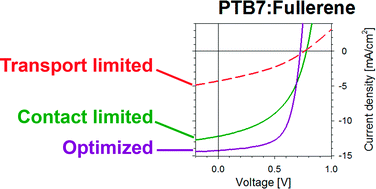In this work we study the different electrical loss pathways occurring during the operation of bulk heterojunction solar cells by using a variety of electrical and optical characterization techniques beyond the current density–voltage curve (J–V): Impedance Spectroscopy (IS), Charge Extraction (CE) and Transient Photovoltage (TPV). Two sets of devices are analyzed: the first is based on the donor polymer P3HT, known to provide efficient cells using thick active layers (i.e. 270 nm), and the recently developed PTB7 which offers maximum efficiencies for devices with thinner layers (i.e. 100 nm). Devices fabricated with P3HT:PC60BM are not limited by transport of carriers and large active layer thickness may be used. Importantly, increasing the active layer thickness does not modify the contact selectivity. This is supported by analysis of the diode curve measured in the dark (similar leakage currents) and by capacitance–voltage measurements (similar fullerene content covering the cathode). Under these conditions the current density curve under illumination is mainly defined by the recombination processes taking place in the bulk of the active layer. In contrast, transport of carriers and contact selectivity are both limiting factors for the PTB7:PC60BM system. In this case, best efficiencies are obtained with a low active layer thickness and a high fullerene ratio. Reduced active layer thickness minimizes undesired electrical resistances related to carrier transport through the bulk of the active layer. High fullerene content enhances the amount of fullerene molecules at the cathode leading to decreased leakage currents. Then, the overall device efficiency will be a combination of the recombination kinetics in the bulk of the active layer, undesired resistance to transport of carriers and leakage current present due to low selectivity of the contact. The use of additives has also been explored which enhances charge generation and extraction. Overall, this work provides a comprehensive guide on how to interpret results obtained from some of the most widely used optoelectronic techniques employed to analyse operating devices.

You have access to this article
 Please wait while we load your content...
Something went wrong. Try again?
Please wait while we load your content...
Something went wrong. Try again?


 Please wait while we load your content...
Please wait while we load your content...